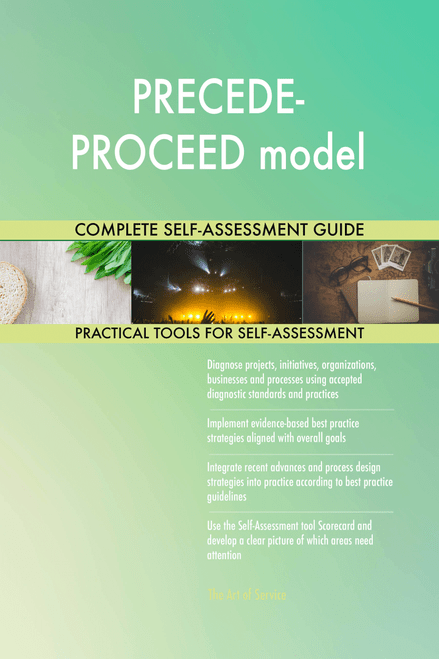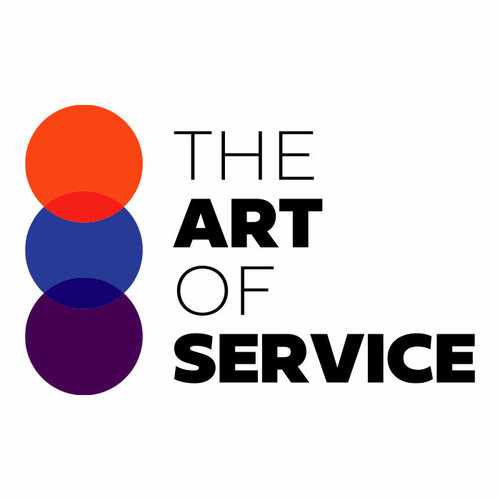Save time, empower your teams and effectively upgrade your processes with access to this practical PRECEDE-PROCEED model Toolkit and guide. Address common challenges with best-practice templates, step-by-step work plans and maturity diagnostics for any PRECEDE-PROCEED model related project.
Download the Toolkit and in Three Steps you will be guided from idea to implementation results.
The Toolkit contains the following practical and powerful enablers with new and updated PRECEDE-PROCEED model specific requirements:
STEP 1: Get your bearings
Start with...
- The latest quick edition of the PRECEDE-PROCEED model Self Assessment book in PDF containing 49 requirements to perform a quickscan, get an overview and share with stakeholders.
Organized in a data driven improvement cycle RDMAICS (Recognize, Define, Measure, Analyze, Improve, Control and Sustain), check the…
- Example pre-filled Self-Assessment Excel Dashboard to get familiar with results generation
Then find your goals...
STEP 2: Set concrete goals, tasks, dates and numbers you can track
Featuring 929 new and updated case-based questions, organized into seven core areas of process design, this Self-Assessment will help you identify areas in which PRECEDE-PROCEED model improvements can be made.
Examples; 10 of the 929 standard requirements:
- How do you effectively use evaluation results to improve action cycle activities?
- Cost-effectiveness analysis in a setting of budget constraints; is it equitable?
- What perceived personal and social barriers (costs) affect learning and action?
- Which services are provided by your program and which are provided by partners?
- Is the program grounded in theory or supported by the best available research?
- Obesity prevention programs for children and youth: why are results so modest?
- What financial resources are available to implement the program that you plan?
- What programs do clients have an interest in that are not currently available?
- If you are the primary provider, what are your strengths as a health educator?
- What activities and/or outcomes of this program matter most to participants?
Complete the self assessment, on your own or with a team in a workshop setting. Use the workbook together with the self assessment requirements spreadsheet:
- The workbook is the latest in-depth complete edition of the PRECEDE-PROCEED model book in PDF containing 929 requirements, which criteria correspond to the criteria in...
Your PRECEDE-PROCEED model self-assessment dashboard which gives you your dynamically prioritized projects-ready tool and shows your organization exactly what to do next:
- The Self-Assessment Excel Dashboard; with the PRECEDE-PROCEED model Self-Assessment and Scorecard you will develop a clear picture of which PRECEDE-PROCEED model areas need attention, which requirements you should focus on and who will be responsible for them:
- Shows your organization instant insight in areas for improvement: Auto generates reports, radar chart for maturity assessment, insights per process and participant and bespoke, ready to use, RACI Matrix
- Gives you a professional Dashboard to guide and perform a thorough PRECEDE-PROCEED model Self-Assessment
- Is secure: Ensures offline data protection of your Self-Assessment results
- Dynamically prioritized projects-ready RACI Matrix shows your organization exactly what to do next:
STEP 3: Implement, Track, follow up and revise strategy
The outcomes of STEP 2, the self assessment, are the inputs for STEP 3; Start and manage PRECEDE-PROCEED model projects with the 62 implementation resources:
- 62 step-by-step PRECEDE-PROCEED model Project Management Form Templates covering over 1500 PRECEDE-PROCEED model project requirements and success criteria:
Examples; 10 of the check box criteria:
- Issue Log: Are you constantly rushing from meeting to meeting?
- Executing Process Group: Why is it important to determine activity sequencing on PRECEDE-PROCEED model projects?
- Quality Audit: How does your organization know that its relationships with the community at large are appropriately effective and constructive?
- Risk Register: People risk -are people with appropriate skills available to help complete the PRECEDE-PROCEED model project?
- Stakeholder Analysis Matrix: Alliances: with which other actors is the actor allied, how are they interconnected?
- WBS Dictionary: Are all elements of indirect expense identified to overhead cost budgets of PRECEDE-PROCEED model projections?
- Project Schedule: PRECEDE-PROCEED model project work estimates Who is managing the work estimate quality of work tasks in the PRECEDE-PROCEED model project schedule?
- Earned Value Status: Validation is a process of ensuring that the developed system will actually achieve the stakeholders desired outcomes; Are you building the right product? What do you validate?
- Cost Management Plan: Estimating responsibilities _ how will the responsibilities for cost estimating be allocated?
- Change Request: Describe how modifications, enhancements, defects and/or deficiencies shall be notified (e.g. Problem Reports, Change Requests etc) and managed. Detail warranty and/or maintenance periods?
Step-by-step and complete PRECEDE-PROCEED model Project Management Forms and Templates including check box criteria and templates.
1.0 Initiating Process Group:
- 1.1 PRECEDE-PROCEED model project Charter
- 1.2 Stakeholder Register
- 1.3 Stakeholder Analysis Matrix
2.0 Planning Process Group:
- 2.1 PRECEDE-PROCEED model project Management Plan
- 2.2 Scope Management Plan
- 2.3 Requirements Management Plan
- 2.4 Requirements Documentation
- 2.5 Requirements Traceability Matrix
- 2.6 PRECEDE-PROCEED model project Scope Statement
- 2.7 Assumption and Constraint Log
- 2.8 Work Breakdown Structure
- 2.9 WBS Dictionary
- 2.10 Schedule Management Plan
- 2.11 Activity List
- 2.12 Activity Attributes
- 2.13 Milestone List
- 2.14 Network Diagram
- 2.15 Activity Resource Requirements
- 2.16 Resource Breakdown Structure
- 2.17 Activity Duration Estimates
- 2.18 Duration Estimating Worksheet
- 2.19 PRECEDE-PROCEED model project Schedule
- 2.20 Cost Management Plan
- 2.21 Activity Cost Estimates
- 2.22 Cost Estimating Worksheet
- 2.23 Cost Baseline
- 2.24 Quality Management Plan
- 2.25 Quality Metrics
- 2.26 Process Improvement Plan
- 2.27 Responsibility Assignment Matrix
- 2.28 Roles and Responsibilities
- 2.29 Human Resource Management Plan
- 2.30 Communications Management Plan
- 2.31 Risk Management Plan
- 2.32 Risk Register
- 2.33 Probability and Impact Assessment
- 2.34 Probability and Impact Matrix
- 2.35 Risk Data Sheet
- 2.36 Procurement Management Plan
- 2.37 Source Selection Criteria
- 2.38 Stakeholder Management Plan
- 2.39 Change Management Plan
3.0 Executing Process Group:
- 3.1 Team Member Status Report
- 3.2 Change Request
- 3.3 Change Log
- 3.4 Decision Log
- 3.5 Quality Audit
- 3.6 Team Directory
- 3.7 Team Operating Agreement
- 3.8 Team Performance Assessment
- 3.9 Team Member Performance Assessment
- 3.10 Issue Log
4.0 Monitoring and Controlling Process Group:
- 4.1 PRECEDE-PROCEED model project Performance Report
- 4.2 Variance Analysis
- 4.3 Earned Value Status
- 4.4 Risk Audit
- 4.5 Contractor Status Report
- 4.6 Formal Acceptance
5.0 Closing Process Group:
- 5.1 Procurement Audit
- 5.2 Contract Close-Out
- 5.3 PRECEDE-PROCEED model project or Phase Close-Out
- 5.4 Lessons Learned
Results
With this Three Step process you will have all the tools you need for any PRECEDE-PROCEED model project with this in-depth PRECEDE-PROCEED model Toolkit.
In using the Toolkit you will be better able to:
- Diagnose PRECEDE-PROCEED model projects, initiatives, organizations, businesses and processes using accepted diagnostic standards and practices
- Implement evidence-based best practice strategies aligned with overall goals
- Integrate recent advances in PRECEDE-PROCEED model and put process design strategies into practice according to best practice guidelines
Defining, designing, creating, and implementing a process to solve a business challenge or meet a business objective is the most valuable role; In EVERY company, organization and department.
Unless you are talking a one-time, single-use project within a business, there should be a process. Whether that process is managed and implemented by humans, AI, or a combination of the two, it needs to be designed by someone with a complex enough perspective to ask the right questions. Someone capable of asking the right questions and step back and say, 'What are we really trying to accomplish here? And is there a different way to look at it?'
This Toolkit empowers people to do just that - whether their title is entrepreneur, manager, consultant, (Vice-)President, CxO etc... - they are the people who rule the future. They are the person who asks the right questions to make PRECEDE-PROCEED model investments work better.
This PRECEDE-PROCEED model All-Inclusive Toolkit enables You to be that person.
Includes lifetime updates
Every self assessment comes with Lifetime Updates and Lifetime Free Updated Books. Lifetime Updates is an industry-first feature which allows you to receive verified self assessment updates, ensuring you always have the most accurate information at your fingertips.











